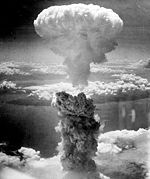- Robert James Moon
-
Robert James Moon (14 February 1911 – 1 November 1989[1]) was an American physicist, chemist and engineer. An important figure in 20th century nuclear science, he was involved in America's wartime Manhattan Project. He was a founding member of the Fusion Energy Foundation and a close collaborator of the LaRouche movement. He pioneered work on the fundamental structure of the atomic nucleus based on platonic solids.
Contents
Life and Work
From a rural background, he arrived at the University of Chicago at the age of 16 in 1928. He earned a Ph.D. degree in physical chemistry under William Draper Harkins and then a doctorate in physics. Starting in the 1930s, he taught at both departments. During World War II, he played a key role in the Manhattan Project. He later conducted biophysical research in connection with the Argonne National Laboratory.
In the 1930s, Moon built the second cyclotron in the world, with many improvements over the first device constructed by Ernest Lawrence. After the war, he constructed the first scanning X-ray microscope and pioneered in optical biophysics studies on the action potential in nerves.
His study of the electrodynamic theories of André-Marie Ampère and Wilhelm Weber led him to reconsider the usual interpretation of the Rutherford scattering data, which ignores the variation in force between charged particles as a result of relative velocities and accelerations. Calculations based on the Weber electrodynamics forced Moon to re-conceptualize most of what is, still today, taken for granted in atomic and nuclear physics.
For some time he was editor-in-chief of the International Journal of Fusion Energy.[2]
Moon model
As an outgrowth of seminars conducted with LaRouche and other scientific collaborators in the 1984 – 1986 period, Moon came up with his proposal for a geometric ordering of protons and neutrons in the atomic nucleus based on nested platonic solids. This "Moon Model"[3], published in Fusion Magazine, is inspired by Johannes Kepler’s conception of the solar system, as described in Kepler's work Mysterium Cosmographicum. The model is also inspired by the discovery by von Klitzing of the quantum Hall effect, leading Moon to believe that space itself is quantized, and that the nucleons are positioned at discrete locations, i.e. at the vertices of a set of nested platonic solids.
Notes
- ^ http://www.jstmoon.com/getperson.php?personID=I13831&tree=jstmoon
- ^ "International Journal of Fusion Energy". FUSION ARCHIVE. Archived from the original on January 20, 2011. http://www.webcitation.org/5vsKGIt7I.
- ^ Hecht & Stevens 2004
References
- Hecht, Laurence; Stevens, Charles B. (Fall 2004), "New Explorations with The Moon Model", 21st Century Science and Technology: p. 58, http://www.21stcenturysciencetech.com/Articles%202005/MoonModel_F04.pdf
External links
- Who was Robert J. Moon?
- The geometric basic for the periodicity of the elements, Laurence Hecht.
- Articles on the Moon Model
- Robert J. Moon, Science and Morality (video)
Manhattan Project Sites 
Administrators Vannevar Bush · James Conant · Thomas Farrell · Leslie Groves · Franklin Matthias · Kenneth Nichols · Robert Oppenheimer · William ParsonsScientists Hans Bethe · Niels Bohr · James Chadwick · Arthur Compton · Enrico Fermi · Richard Feynman · Klaus Fuchs · George Kistiakowsky · Ernest Lawrence · William Penney · Emilio G. Segrè · Glenn T. Seaborg · Leó Szilárd · Edward Teller · Richard C. Tolman · Stanislaw Ulam · Harold Urey · Leona Woods · Chien-Shiung WuRelated articles Timeline · History of nuclear weapons · Nuclear weapons and the United States · S-1 Uranium Committee · Chicago Pile-1 · X-10 Graphite Reactor · Y-12 National Security Complex · Operation Alsos · Smyth Report · Project Alberta · 509th Operations Group · Fat Man · Little Boy · Enola Gay · Bockscar · The Great Artiste · Atomic bombings of Hiroshima and Nagasaki (debate) · Atomic Spies · Atomic Energy Act of 1946 · Operation Crossroads · Tube AlloysCategories:- 1911 births
- 1989 deaths
- American physicists
- University of Chicago faculty
- University of Chicago alumni
- Manhattan Project people
Wikimedia Foundation. 2010.
